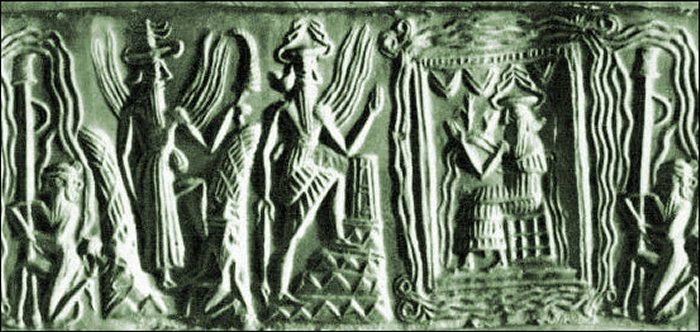


Tiamat was the "shining" personification of salt water who roared and smote in the chaos of original creation. Lahmu and Lahamu, in turn, were the parents of the 'ends' of the heavens ( Anshar, from an = heaven, shár = horizon, end) and the earth ( Kishar) Anshar and Kishar were considered to meet at the horizon, becoming, thereby, the parents of Anu (the Heavens, Biblical " Shemayim") and Ki (the Earth, Biblical " Eretz" created by Elohim in Genesis 1:1). the "hairy"), a title given to the gatekeepers at Enki's Abzu/E'engurra-temple in Eridu. The strictly modern depiction of Tiamat as a multi-headed dragon was popularized in the 1970s as a fixture of the Dungeons & Dragons roleplaying game inspired by earlier sources associating Tiamat with later mythological characters, such as Lotan.Ībzu (or Apsû) fathered upon Tiamat the elder deities Lahmu and Lahamu (masc. She has insides (possibly "entrails"), a heart, arteries, and blood. In the Enûma Elish her physical description includes a tail, a thigh, "lower parts" (which shake together), a belly, an udder, ribs, a neck, a head, a skull, eyes, nostrils, a mouth, and lips. The Enûma Elish specifically states that Tiamat did give birth to dragons and serpents, but they are included among a larger and more general list of monsters including scorpion men and merpeople, none of which imply that any of the children resemble the mother or are even limited to aquatic creatures. Though Tiamat is often described by modern authors as a sea serpent or dragon, no ancient texts exist in which there is a clear association with those kinds of creatures, and the identification is debated. Tiamat also has been claimed to be cognate with Northwest Semitic tehom (תהום) ( the deeps, abyss), in the Book of Genesis 1:2. The difference in density of salt and fresh water drives a perceptible separation. This characteristic is especially true of the region of Bahrain, whose name in Arabic means "two seas", and which is thought to be the site of Dilmun, the original site of the Sumerian creation beliefs. Harriet Crawford finds this "mixing of the waters" to be a natural feature of the middle Persian Gulf, where fresh waters from the Arabian aquifer mix and mingle with the salt waters of the sea. It is thought that female deities are older than male ones in Mesopotamia and Tiamat may have begun as part of the cult of Nammu, a female principle of a watery creative force, with equally strong connections to the underworld, which predates the appearance of Ea-Enki. The Babylonian epic Enuma Elish is named for its incipit: "When above" the heavens did not yet exist nor the earth below, Apsu the freshwater ocean was there, "the first, the begetter", and Tiamat, the saltwater sea, "she who bore them all" they were "mixing their waters". He finds the later form, thalatth, to be related clearly to Greek Θάλαττα (thalatta) or Θάλασσα (thalassa), "sea". Thorkild Jacobsen and Walter Burkert both argue for a connection with the Akkadian word for sea, tâmtu, following an early form, ti'amtum.īurkert continues by making a linguistic connection to Tethys. It is thought that the name of Tiamat was dropped in secondary translations of the original religious texts because some Akkadian copyists of Enûma Elish substituted the ordinary word for "sea" for Tiamat, since the two names had become essentially the same, due to association. Tiamat was known as Thalattē (as a variant of thalassa, the Greek word for "sea") in the Hellenistic Babylonian Berossus' first volume of universal history. The heavens and the earth are formed from her divided body. In the Enûma Elish, the Babylonian epic of creation, she gives birth to the first generation of deities she later makes war upon them and is killed by the storm-god Marduk. Although there are no early precedents for it, some sources identify her with images of a sea serpent or dragon. In the second " Chaoskampf" Tiamat is considered the monstrous embodiment of primordial chaos. It is suggested that there are two parts to the Tiamat mythos, the first in which Tiamat is 'creatrix', through a " Sacred marriage" between salt and fresh water, peacefully creating the cosmos through successive generations. In Babylonian mythology, Tiamat is a chaos monster, a primordial goddess of the ocean, mating with Abzû (the god of fresh water) to produce younger gods.


 0 kommentar(er)
0 kommentar(er)
